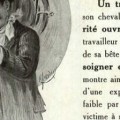“When we try to pick out anything by itself, we find it hitched to everything else in the Universe.”— John Muir – image
4+ interesting minutes.
When wolves were reintroduced to Yellowstone National Park in the United States after being absent nearly 70 years, the most remarkable “trophic cascade” occurred. What is a trophic cascade and how exactly do wolves change rivers? George Monbiot explains in this movie remix.
Trophic cascades occur when predators in a food web suppress the abundance or alter traits (e.g., behavior) of their prey, thereby releasing the next lower trophic level from predation (or herbivory if the intermediate trophic level is a herbivore).
~ A classic example of a terrestrial trophic cascade is the reintroduction of gray wolves (Canis lupus) to Yellowstone National Park, which reduced the number and behavior of elk (Cervus elaphus). This in turn released several plant species from grazing pressure and subsequently led to the transformation of riparian ecosystems. This example of a trophic cascade is vividly shown and explained in a viral video “How Wolves Change Rivers.” ~ – Wiki
NOTE: There are “elk” pictured in this video when the narrator is referring to “deer.” This is because the narrator is British and the British word for “elk” is “red deer” or “deer” for short. The scientific report this is based on refers to elk so we wanted to be accurate with the truth of the story.
………………………………………………………………………………………………………
Our Projects
The Henry Salt Archive is one of our, almost completed, projects.
The Humanitarian League is our Hong Kong registered charity.
The Ernest Bell Library was conceived in 1934. It is still strong & very active eighty years later – its primary objectives are to: –
-
Collect all of Ernest Bell’s book & non-book works and make them easily accessible to everyone.
-
Collect the literature of vegetarianism and all the other humanitarian movements in which Ernest Bell was so deeply involved.
-
Assist students and scholars in their research.
-
Introduce all aspects of Ernest Bell’s life, including his writings, campaign work, influences and his circle of friends.
-
Undertake our own research into missing aspects of Ernest Bell’s life and work.
We already have more than 300 pieces of Ernest Bell’s own writings.
We are also actively building a collection of examples of promotional material, campaign material, fundraising & marketing activities etc. – related to: –
-
veg(etari)an products.
-
veg(etari)an books & other publications.
-
veg(etari)an organisations.
-
veg(etari)an businesses.
-
animal rights organisations.
-
animal rights publications.
-
humanitarian organisations.
-
humanitarian publications.
-
rambling clubs run by members of the above groups & related publications.
-
the work of Richard St. Barbe Baker & the ‘Men of the Trees’ organization & its many sub-branches.








No Comments